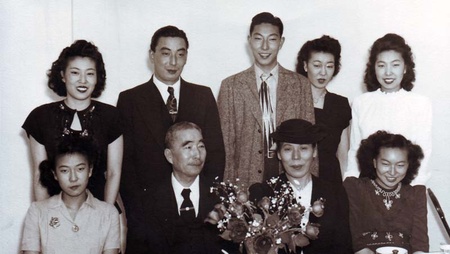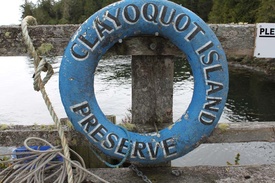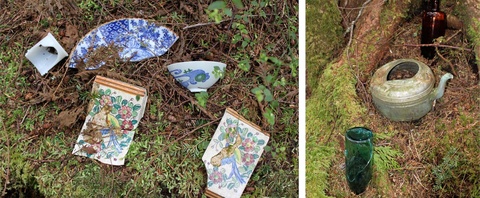For one weekend each year in May, the Clayoquot Island Preserve hosts an open house which allows the public to visit the privately owned island located one nautical mile across from Tofino. Tofino residents and tourists alike pack picnic lunches and line up at the First Street Dock for free boat shuttles to the island.
The open house coincides with the blooming of the magnificent rhododendron gardens. Visitors picnic, play games, hike, beachcomb, and explore the 250-acre island of mature old growth Coastal Hemlock forest, second growth forest, sand dunes, beaches, and gardens.
Clayoquot Island Preserve is not only an important ecological preserve and showcase for sustainable living off the grid, but it’s also an important historical location for the Japanese Canadian community.
Clayoquot Island, also known as Stubbs Island on marine charts, is steeped in history, beginning with the Nuu-Chah-Nulth people who lived on its shores and surrounding areas of Clayoquot Sound. Europeans began settling on Stubbs Island by the mid-1850s. In 1855 a trading post was established by Banfield and Frances Ltd.
In the days before Tofino existed, Clayoquot Village on Stubbs Island was the commercial hub of the region and was one of the first trading posts outside of Fort Victoria. By 1899, the trading post had become a small fishing village with its population listed as 150 whites and 250 natives. There was a hotel, a school, a jailhouse, gold assay office, beer parlour and general store. By the 1890s, ships bound for the Bering Sea were outfitted there and it was not uncommon for as many as 16 schooners to be moored at the island. By this time the population started to get too big for the small island and more people settled into the village of Tofino across the harbour.
By the 1900s Japanese settlers began to arrive and created their own small fishing community on the west side of Clayoquot Island. My own great-grandfather, Naoichi Karatsu, and his friend Mr. Okada arrived on Clayoquot Island after the Russo-Japanese war of 1905.
Ruby Middeldorp (nee Karatsu), Naoichi’s daughter, said they were originally planning on immigrating to South America, “They landed there wondering why the people were not speaking Spanish. They asked, and someone told them that this was Vancouver. They liked the mountains and decided to stay.”
Naoichi Karatsu eventually did make his way to the real city of Vancouver. He settled in the fishing village of Steveston and his wife, Sen, gave birth to two children, Alice and Peter. By 1922, Naoichi decided to move his growing family to the spot where he first landed in British Columbia: Clayoquot Island.
A number of other Japanese Canadian families settled on the west beach at the same time and it became a thriving fishing community with often as many as 30-40 Japanese fishing boats anchored at the island. Some of the other Japanese Canadians who settled there were the Igarashi, Katsuro, Kimoto, and Okada families.
The Karatsu family lived on Clayoquot Island from 1922 until the evacuation in 1942. During that time, Sen Karatsu gave birth to six more children—Rennie, Ivy, Celia, Gloria, Norah, and Ruby—at home with help from their next-door neighbour, Mrs. Okada, who acted as midwife.

The Karatsu family in Toronto in the late 1940s. Top row from left: Celia, Peter, Rennie, Ivy and Norah. Bottom row from left: Gloria, father Naoichi, mother Sen, and Ruby. (Missing from the photo are sisters Alice and Marie).
Life on Clayoquot was simple but idyllic. Naoichi became a naturalized Canadian citizen very early so he was able to fish there with his motorized fishing vessel named NK. He was also the community’s unofficial medic. (Naoichi acquired some medical skills while working as an orderly for the Japanese medical corps during the Russo-Japanese war, before he immigrated to Canada.) He offered his medical knowledge to the First Nations people in the area, inoculating children and administering first aid. One time a local tribe repaid him with a canoe full of kazunoko!
By all accounts, it sounded like growing up on Clayoquot Island was fun. The Karatsu children attended school together with the other kids on the island. They had a huge sandbar they could explore at low tide, forests to discover and play in, and they were even allowed to row across the channel without life jackets and without adult supervision! Times were different then.
Their quiet existence on this little isolated island came to an end in 1942 when the Canadian government forcibly evacuated all Japanese Canadians from the British Columbia coast. Most of the Japanese Canadian inhabitants of Clayoquot Island would never see the island, or the homes that they built there, ever again.
From the 1940s to 1990, Clayoquot Island was sold to a series of private owners. In 1990, it was purchased by the current owner Susan Bloom who turned it into a wildlife refuge and preserve. In 2007, Bloom registered a conservation covenant on the property with The Land Conservancy of British Columbia that covers 70% of the island. A conservation covenant is a voluntary legal agreement between a landowner and TLC which the landowner promises to protect the land in specific ways. The covenant is attached to the title’s land forever, regardless of who owns the land in the future. TLC then agrees to monitor the covenant and ensures that its objectives are maintained. In the case of Clayoquot Island, the covenant will ensure that the old growth forest, historic Japanese village site, and shoreline for bird-nesting habitat will remain in its natural state.
Today, Clayoquot Island’s permanent population is two: caretakers Sharon Whalen and Chris Taylor. They live off the grid, using solar panels to power generators and a sand filtering system to make potable water. The caretakers tend to the island’s magnificent gardens.
In the early 1900s, an annual festival called Clayoquot Days took place on the island every May long weekend. In commemoration of this tradition, Clayoquot Island Preserve is open to the public once a year on the May long weekend.
During the 2011 open house, I took the opportunity to visit the island and see where my great-grandfather and his family lived before the war. Ruby Middeldorp also visited the island that weekend, her first visit since the evacuation in 1942.
Upon disembarking from the boat shuttle, I walked down the long wharf towards the caretaker’s cottage. There, a volunteer handed me a brochure and map of the island. Retracing my steps back to the wharf, I veered off along a forest path toward the old Japanese village site. The path is marked with broken pottery and other Japanese artifacts left behind by its residents.
No homes remain at the Japanese village site. Second growth forest and bush make it difficult to get to the beachsite. But persistence pays off and soon I’m rewarded with a deserted sandy grey beach filled with mussel beds and a sweeping vista of Clayoquot Sound. Seeing the location of the old Japanese village site on Clayoquot Island for the first time is bittersweet. It truly must have been paradise for the Karatsus and all the other Japanese Canadian families who lived there.
*This article was originally published in Nikkei Images (Summer 2012 Vol. 17, No. 2), a publication of the Nikkei National Museum & Cultural Centre.
© 2012 Christine Kondo





